





Retina is the covering of tissue at the rear of the eye that detects light and communicates with the brain enabling the person to see. It has rod and cone photoreceptor cells, which are in charge of turning light into electrical impulses that go via the optic nerve to the brain.
The diabetes-related eye condition known as diabetic retinopathy damages the retina, the light-sensitive tissue located in the rear of the eye. It is a frequent side effect of diabetes and the main reason why diabetics lose their vision.
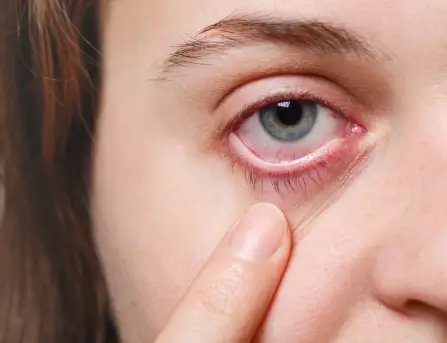
Damage to the blood vessels in the retina, the light-sensitive tissue located in the back of the eye, results in diabetic retinopathy, a consequence of diabetes that affects the eyes. The exact cause of diabetic retinopathy is not fully understood, but several factors contribute to its development:
1.Chronically elevated blood sugar levels (hyperglycemia)
Over time, high blood glucose levels can damage the retina's tiny blood vessels. Long-term hyperglycemia damages vessels by causing oxidative stress and inflammation.
2.Hypertension (high blood pressure)
The harm that high blood sugar levels can bring can be made worse by elevated blood pressure. The blood vessels are under more stress due to hypertension, which raises the possibility of retinal hemorrhage and leakage.
3.Duration of diabetes
The chance of having diabetic retinopathy increases with the length of diabetes. The retinal blood vessels are harmed over time by the combined effects of hyperglycemia and other metabolic abnormalities.
4.Type of diabetes
Diabetic retinopathy can be caused by either type 1 or type 2 diabetes, however those with poorly controlled blood sugar may be more susceptible to the condition. Complications from type 2 diabetes may arise from a number of additional risk factors, including obesity, insulin resistance, and lifestyle choices.
5.Genetic factors
A person's vulnerability to diabetic retinopathy may be influenced by a genetic predisposition. A hereditary predisposition to diabetes or its consequences, including eye problems, may exist in certain individuals.
6.Smoking
Smoking can hasten the course of diabetic retinopathy and is a recognized risk factor for the condition. Smoking exacerbates the effects of diabetes on blood vessels and adds to vascular damage.
7.Dyslipidemia
Hypercholesterolemia and hypertriglyceridemia are examples of abnormal blood lipid (fat) levels that are linked to a higher risk of diabetic retinopathy.
8.Pregnancy
Diabetes during pregnancy may cause changes in blood pressure and blood sugar, which raises the risk of diabetic retinopathy.
Diabetes mellitus can be managed, and its risk reduced by routine blood pressure, cholesterol, and blood sugar monitoring, lifestyle changes, and prompt medical attention. The condition's accompanying visual loss can be prevented or minimized with early discovery and treatment. For those with diabetes, routine eye exams are advised in order to identify and treat any symptoms of diabetic retinopathy.
There are two main types of Diabetic Retinopathy: Non-proliferative Diabetic Retinopathy (NPDR) and Proliferative Diabetic Retinopathy (PDR)
1 Non-proliferative Diabetic Retinopathy (NPDR)
NPDR (Non-proliferative Diabetic Retinopathy) or early Diabetic Retinopathy, is often referred to as background retinopathy. Small blood vessels in the retina leak blood or fluid in NPDR, which results in edema or swelling. Small blood vessel bulges known as microaneurysms can also form. Although there may not be any symptoms at first, routine eye exams are essential for early identification and treatment of NPDR.
2 Proliferative Diabetic Retinopathy (PDR)
Proliferative Diabetic Retinopathy (PDR) is the most severe and advanced form of diabetic retinopathy. Neovascularization, the formation of new blood vessels on the surface of the retina and inside the vitreous gel that fills the eye, is what happens at this stage. Because of their fragility, these new blood vessels may leak into the vitreous, which might result in floaters or visual loss. Additionally, scar tissue may form, which might result in retinal detachment and profound visual loss.
Additionally, diabetic retinopathy can be classified based on the extent and severity of the disease
1.Mild Non-proliferative Diabetic Retinopathy
Characterized by retinal hemorrhages and a small number of microaneurysms.
2.Moderate Non-proliferative Diabetic Retinopathy
There are more hemorrhages and microaneurysms visible at this stage.
3.Severe Non-proliferative Diabetic Retinopathy
Marked by more drastic alterations to the blood vessels, such as the closure of certain blood vessels, which results in a decreased blood flow to the retina.
4.Very Severe Non-proliferative Diabetic Retinopathy
There are a lot of occluded blood vessels at this stage, and proliferative diabetic retinopathy is more likely to develop in the future.
For people with diabetes to properly manage their condition and identify diabetic retinopathy early, routine eye exams are essential. The risk of vision loss can be decreased, and the course of diabetic retinopathy can be stopped or slowed down with early intervention and appropriate therapy, such as surgery or laser treatment. To monitor and maintain their eye health, people with diabetes should collaborate closely with their healthcare team, which includes eye care professionals.
A consequence of diabetes that impacts the eyes, more precisely the retina, is called diabetic retinopathy. Damage to the blood vessels in the retina is the underlying cause of the disorder, which, if ignored, can result in visual issues and even blindness. For those with diabetes, routine eye exams are essential since the early signs of diabetic retinopathy may not be apparent. As the illness worsens, the following signs and symptoms might appear
1.Distorted or blurred vision
Objects may look distorted, and eyesight may become fuzzy.
2.Floaters
Secondly, there are those little dots or shadows that appear to float in your range of view.
3.Fluctuating vision
At different intervals, eyesight may get better or worse.
4.Impaired color vision
Accurate color perception is difficult.
5.Dark or empty areas in vision
These might be signs of retinal hemorrhage or fluid leaking.
6.Difficulty seeing at night
Issues with low light and night vision.
Individuals who with diabetes should get frequent eye exams, and they should notify an eye care specialist right once if their vision changes. Diabetes can be managed to prevent or decrease the growth of diabetic retinopathy by maintaining a healthy lifestyle, taking regular exercise, and controlling blood sugar levels.
Depending on the severity of the problem, laser therapy, injections, or surgery may be the course of treatment if diabetic retinopathy is identified. Maintaining vision and averting more difficulties need routine monitoring and prompt management. It's critical to collaborate closely with your eye care expert and other members of your healthcare team to manage and track both your general and eye health if you have diabetes.
A thorough eye examination, imaging investigations, and medical history are usually used to diagnose diabetic retinopathy. This is a synopsis of the diagnostic procedure
Medical History: Healthcare practitioners may question a patient about their medical history who will pay particular attention to the onset, course, and degree of diabetes as well as the management of their blood sugar levels.
Visual Acuity Test: This simple eye test evaluates your vision at different distances. To evaluate your visual acuity, you must read an eye chart.
Dilated Eye Exam: This is an important component in the diagnosis of diabetic retinopathy. Patient’s eyes will be dilated by the eye specialist using eye drops, enabling a more thorough retinal examination. Examining the blood vessels and other structures in the back of the eye is made easier by the dilatation.
Fundus Photography: To acquire fine-grained pictures of the retina, Fundus photography is implemented during a dilated eye exam. These photos serve as a reference point and aid in tracking alterations over time.
Fluorescein Angiography: A fluorescein angiography could be necessary in specific circumstances. In order to do this test, a dye will be injected into a vein in your arm, and pictures will be taken as the dye passes through the retina's blood vessels. It assists in locating blood vessel leaks and locations with insufficient blood flow.
Optical Coherence Tomography (OCT): This imaging technique creates cross-sectional, fine-grained pictures of the retina using light waves. OCT is very helpful in identifying retinal thickness or enlargement.
Tonometry: The pressure inside the eye is measured by Tonometry test. In addition to diabetic retinopathy, other eye disorders may also present as elevated eye pressure.
Visual Field Testing: Peripheral vision testing is done by this method. Visual field loss may result from advanced diabetic retinopathy.
The progression of diabetic retinopathy must be prevented or slowed down by early identification and treatment. In the event that diabetic retinopathy is discovered, your healthcare professional will decide on the best course of action, which may involve medication, lifestyle changes, or surgery, depending on how severe the problem is. For people with diabetes to track and manage any changes in their eye health, routine eye exams are crucial.
Diabetes can cause eye complications called diabetic retinopathy, which, if unchecked, can cause blindness or vision impairment. Diabetic retinopathy is managed with a combination of surgical and medicinal treatments. It is imperative that diabetics regulate their blood sugar levels well and have routine eye exams in order to identify and treat diabetic retinopathy as soon as possible.
Some common treatments for Diabetic Retinopathy
Blood Sugar Control: Maintaining strict blood sugar management is necessary to halt the development of diabetic retinopathy. This entails consistent tracking, following prescription guidelines, and making lifestyle changes including eating a balanced diet and getting frequent exercise.
Blood Pressure Management: Managing hypertension is essential to the treatment of diabetic retinopathy. It is customary to advise medication, lifestyle modifications, and routine blood pressure monitoring.
Intravitreal Injections: Anti-VEGF (vascular endothelial growth factor) drugs can be injected into the eye to lessen swelling and leaking from aberrant blood vessels. Examples of these drugs are ranibizumab (Lucentis), aflibercept (Eylea), and bevacizumab (Avastin).
Laser Photocoagulation: Laser therapy is a treatment option for aberrant blood vessels and a way to lower the risk of visual loss. Whereas aberrant blood vessels are shrunk by pan retinal photocoagulation, focal laser therapy focuses on specific sites of leakage.
Vitrectomy: Vitrectomy surgery may be indicated in advanced instances of diabetic retinopathy with vitreous hemorrhage or tractional retinal detachment. This entails clearing the vitreous humor of the gel-like material that surrounds the eye of blood and scar tissue.
Intravitreal Steroid Injections: It is possible to inject steroids into the eye to lessen swelling and irritation. In rare situations of diabetic macular edema, this may be a viable alternative.
Regular Eye Exams: The management of diabetic retinopathy depends heavily on early identification and intervention. People with diabetes should get regular eye exams, preferably once a year, to keep an eye on their eye health.
Early intervention and proper management can significantly reduce the risk of vision loss.
Diabetic retinopathy is caused when the blood vessels in the retina are damaged by high blood sugar levels. Adopting a healthy lifestyle and maintaining appropriate blood sugar control are essential for the prevention and management of diabetic retinopathy.
Safety measures and preventives for Diabetic retinopathy
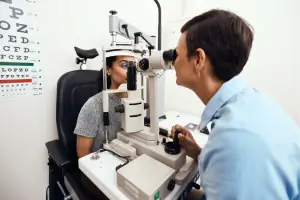
Regular Eye Exams
A thorough dilated eye exam should be performed on diabetics at least once a year. Vision loss can be avoided with early identification and prompt treatment.
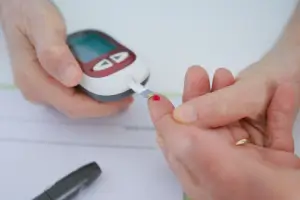
Blood Sugar Control
Observe the target blood glucose levels that have been prescribed by your physician. Maintaining stable blood sugar levels can greatly lower the chance of developing diabetic retinopathy.
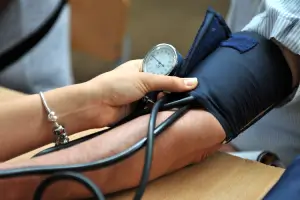
Blood Pressure Management
Lower your blood pressure since it can accelerate the development of diabetic retinopathy. Observe the advice given by your healthcare practitioner in order to control your blood pressure.

Healthy Diet
Eat a well-rounded, healthful diet that is high in fruits, vegetables, whole grains, lean meats, and low-fat dairy products. Restrict your consumption of processed foods, sweet snacks, and heavy meals.

Regular Exercise
Regular physical activity lowers blood sugar levels and enhances cardiovascular health in general. Be sure to speak with your doctor before beginning a new fitness program.

Medication Adherence
As instructed by your healthcare professional, take prescribed drugs. This covers insulin, prescription drugs taken orally, and any additional drugs used to treat diabetes and associated illnesses.

Quit Smoking
In addition to raising the risk of other diabetes-related problems, smoking can exacerbate diabetic retinopathy. Giving up smoking is good for your general health.
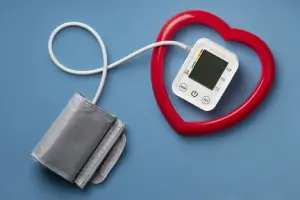
Control Cholesterol Levels
Control cholesterol levels with a nutritious diet and, if required, medicine. Elevated cholesterol levels may worsen diabetic retinopathy by exacerbating cardiovascular issues.
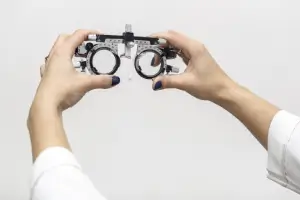
Regular Monitoring of Vision
Keep an eye out for changes in your eyesight and notify your eye care professional right away if you see anything unusual. Treatment that is more successful might result from early recognition of visual abnormalities.

Foot Care
Diabetes-related problems are frequently linked to diabetic retinopathy. It's essential to take good care of your feet to avoid infections and other problems that might harm your general health.

Stress Management
Engage in stress-relieving activities like yoga, meditation, and deep breathing. Both blood sugar levels and general health might be adversely affected by ongoing stress.

Educate Yourself
Keep an update on diabetic care, including prescription drugs, dietary adjustments, and possible side effects. Attend diabetic education programs if they are offered.
Retinopathy Costs/ Insurance
If you qualify for Medicare, the costs of retinopathy are typically covered. Cataract surgeries are also covered by private insurance.
If your vision tests at a certain level of clarity or acuity, Medicare will pay for your care. Similar vision requirements may apply to private insurance plans. Even if your surgery is covered, there might be some additional costs. IOLs of special types will cost more. It will be more expensive to decide to have cataract surgery before your vision has become significantly worse.
It may be possible in some circumstances to obtain coverage prior to meeting the age or vision requirements. See your ophthalmologist if you're thinking about undergoing early cataract surgery.
TPA / INSURANCE

bajaj allianz health insurance

aditya birla health insurance

acko general insurance

E Meditek Tpa Services Ltd

HDFC ERGO General Insurance Company

Heritage Insurance

icici lombard health insurance

IFFCO TOKIO

medi assist insurance tpa pvt ltd

Medsave Healthcare

The Oriental Insurance Company

Paramount Health Insurance

Reliance General Insurance

SBI General Insurance

Star Health

The New India Insurance

Vidal Health Insurance

care health insurance

Ericson Insurance TPA Pvt. Ltd

FHPL

Good Health TPA

Health India

Health Insurance (HI)

Md India

National Insurance

Park Mediclaim

Raksha

Safeway

United Health Care

United India Insurance

East West Tpa
Government Schemes

Naval Dockyard
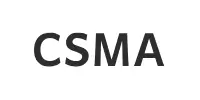
CSMA

CGHS